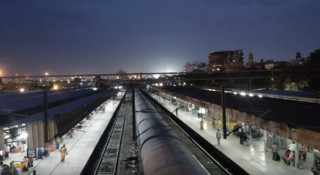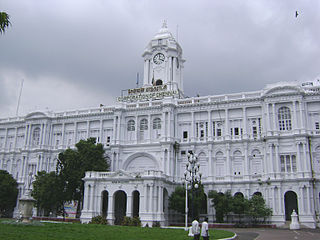Related Research Articles

The Connemara Public Library at Egmore in Chennai, Tamil Nadu, India, is one of the four National Depository Libraries which receive a copy of all books, newspapers and periodicals published in India. Established in 1896, the library is a repository of century-old publications, wherein lie some of the most respected works and collections in the history of the country. It also serves as a depository library for the United Nations. It is located in the Government Museum Complex on Pantheon Road, Egmore, which also houses the Government Museum and the National Art Gallery.
Chennai Egmore, formerly known as Madras Egmore, also known as Chennai Elumbur, is a railway station in Chennai, Tamil Nadu, India. Situated in the neighborhood of Egmore, it is one of the four intercity railway terminals in the city; the other three are Chennai Central railway station, Tambaram railway station and Chennai Beach railway station. The station was built in 1906–1908 as the terminus of the South Indian Railway Company. The building built in Gothic style is one of the prominent landmarks of Chennai. The main entrance to the station is situated on Gandhi-Irwin Road and the rear entrance on Poonamallee High Road.

Puratchi Thalaivar Dr. M.G. Ramachandran Central Railway Station, commonly known as Chennai Central, is the main railway terminus in the city of Chennai, Tamil Nadu, India. It is the busiest railway station in South India and one of the most important hubs in the country. It is connected to Moore Market Complex railway station, Chennai Central metro station, Chennai Park railway station, Chennai Park Town railway station and is 2 km from Chennai Egmore railway station. The terminus connects the city to northern India, including Kolkata, Mumbai, New Delhi as well as to Bangalore, Ahmedabad, Guwahati, Chandigarh, Kerala,Hyderabad and different parts of India.

The Government Museum, Chennai, or the Madras Museum, is a museum of human history and culture located in the Government Museum Complex in the neighbourhood of Egmore in Chennai, India. Started in 1851, it is the second oldest museum in India after the Indian Museum in Kolkata. It is particularly rich in archaeological and numismatic collections. It has the largest collection of Roman antiquities outside Europe. Among them, the colossal Museum Theatre is one of the most impressive. The National Art Gallery is also present in the museum premises. Built in Indo-Saracenic style, it houses rare European and Asian painting of renowned artists, including that of Raja Ravi Varma. It had 0.6 million visitors in 2018. It has the richest collections of bronze idols, 500 of them dating to 1000 BCE, in Asia.

Chennai architecture is a confluence of many architectural styles. From ancient Tamil temples built by the Pallavas, to the Indo-Saracenic style of the colonial era, to 20th-century steel and chrome of skyscrapers. Chennai has a colonial core in the port area, surrounded by progressively newer areas as one travels away from the port, punctuated with old temples, churches and mosques.

The Chennai Metro is a rapid transit system serving the city of Chennai, Tamil Nadu, India. It is the 4th longest metro system In india. The system commenced service in 2015 after partially opening the first phase of the project. The network consists of two colour-coded lines covering a length of 54.65 kilometres (33.96 mi). The Chennai Metro Rail Limited (CMRL), a joint venture between Government of India and the Government of Tamil Nadu built and operates the Chennai Metro. The system has a mix of underground and elevated stations and uses standard gauge. The services operate daily between 4:30 and 23:00 with a varying frequency of 5 to 14 minutes.

Chennai Beach is a railway terminus of the Southern Railway network in Parry's Corner, Chennai, India. Built on reclaimed land, the station serves the suburban services of the Chennai Suburban Railway and Mass Rapid Transit System (Chennai) and a few passenger trains. It serves as the northern terminus for the Chennai MRTS line. The station is named after High Court Beach, which was later built up as part of Chennai Port, and not after the Marina Beach, which is located a few kilometres away and is served by Chepauk, Triplicane and Lighthouse stations of the MRTS line. The station consists of 1500 square metres of open parking area.

The Chennai Suburban Railway is a commuter rail system in the city of Chennai, Tamil Nadu, India, operated by the Southern Railways branch of Indian Railways. It is the second largest suburban rail network in terms of route length and the third largest in terms of commuters in India. Around 1,000 services are operated daily between 4:00 a.m. and midnight. It is the longest suburban circular route in India covering of 235.5 km (146.3 mi).

The Ripon Building is the seat and headquarters of the Greater Chennai Corporation in Chennai, Tamil Nadu. It is an example of neoclassical architecture, a combination of Ionic and Corinthian styles. The Ripon Building is an all-white structure and is located near the Dr. M.G.R Railway Station.

Tambaram is one of the railway terminals of the Chennai Beach–Tambaram section of the Chennai Suburban Railway Network. It is situated at a distance of 6 kilometres (3.7 mi) from the centre of Tambaram. It is situated in South Chennai and located 27 kilometres (17 mi) from Chennai Beach station. It is one of the fastest-growing railway hubs outside Chennai Central in the southern direction. Every day, on an average, around 3,50,000 commuters use the station. About 500 suburban electric trains operate from Tambaram, including those between Chennai Beach and Chengalpattu and Kancheepuram. Further, more than 25 express trains, including those bound for Howrah and other places in the northern India, pass through the town. It is also the third busiest station in the city. It is one of the four railway terminals within Chennai City. The daily ticket sales at Tambaram fetch ₹ 1 million, half of which comes from suburban travellers. It is the second most revenue-generating station in Chennai after Moore Market Complex. A total of 52 trains pass through the station.

Royapuram railway station is a railway station at Royapuram, on the Chennai Beach–Walajapet section of the Chennai Suburban Railway network in Chennai, India. It is the second oldest railway station currently operational in India after Howrah railway station situated in Howrah, West Bengal and the first railway station of South India. The first train of South India started operating in June 1856 from Royapuram railway station. The station also remained the headquarters of the Madras and Southern Mahratta Railway till 1922, when the headquarters was shifted to Egmore. Since the original structures of Bombay and Thane stations no longer exist, Royapuram station remains the oldest railway station in the entire subcontinent.

Southern Railway headquarters administrative building, Chennai, is an Indo-Saracenic structure located adjacent to the Chennai Central on Poonamallee High Road.

The National Art Gallery situated in Egmore, Chennai, is one of the oldest art galleries in India. It is located in the Government Museum Complex on Pantheon Road, Egmore, which also houses the Government Museum and the Connemara Public Library. Constructed with red stones sourced from Satyavedu in Andhra Pradesh, the Gallery was built in 1906 in Indo-Sarsenic architecture and houses paintings from Thanjavur, Rajasthan, Kangra and Deccan areas, as well as sandalwood sculptures. The Gallery has remained closed since 2002, as part of the structure suffered damage.

Tamil Nadu Government Multi-Super-Speciality Hospital is a 400-bed government-owned super-speciality hospital in Chennai, India. It is located at the Omandurar Government Estate on Anna Salai and was opened in February 2014. Originally built as Tamil Nadu legislative assembly and secretariat complex in 2010 to house the assembly hall, secretariat and offices of the chief minister and cabinet ministers, the complex was later converted into a super-speciality hospital. It was built in 1.93 million sq ft. at a total cost of ₹ 4,250 million in 2010.
Chennai, with historically rich records dating at least from the time of the Pallavas, houses 2,467 heritage buildings within its metropolitan area (CMA), the highest within any Metropolitan Area limit in India. Most of these buildings are around 200 years old and older. Some of them are Chennai Central, Chennai Egmore, Ripon Building, Senate House, Bharat Insurance Building, and so forth. Chennai is home to the second largest collection of heritage buildings in the country, after Kolkata. The official list of heritage buildings was compiled by the Justice E. Padmanabhan committee. The Tamil Nadu Assembly passed the Heritage Commission Act in 2012 to preserve old heritage structures.

M.G.R Memorial Complex is a memorial complex built on the Marina beach in Chennai, Tamil Nadu, India. Spread over 8.25 acres, the memorial is located adjacent to the Anna Memorial. It was built in memory of former chief ministers of Tamil Nadu who died in office, M. G. Ramachandran and his protégé J. Jayalalithaa, whose bodies were buried at the site on 25 December 1987 and 6 December 2016, respectively.

Kollam Junction railway station is a junction station situated in the city of Kollam in Kerala, India. It is the second largest railway station in Kerala in terms of area and largest in terms of number of tracks and one of the oldest railway stations in the state. It is also the second busiest railway station in Kerala in terms of trains handled per day. World's third longest railway platform is situated at Kollam railway station.
The Central Square is an city square and major intersection in Chennai. Areas surrounding the Ripon Building, Victoria Public Hall, Moore Market Complex, Chennai Central Railway Station, the Southern Railway Headquarters and the Government General Hospital are being developed as part of the Central Square. The total site area is estimated to be about 37,800 square meter, and the development is estimated to cost about ₹4 billion (US$50 million) and will be funded by the CMDA.
This is the timeline for Southern Railway zone that encompasses over present day Tamil Nadu, Kerala and parts of Andhra Pradesh and Karnataka.
Tamil Nadu Police Museum is a museum in Chennai, India. Located in Pantheon Road in the neighbourhood of Egmore, the museum was opened in September 2021. The museum has a repository of exhibits marking the passage of the state's law enforcement agency from colonial India to the modern day.
References
- ↑ "Inauguration of renovated heritage Egmore court delayed". The Times of India. April 30, 2019. Retrieved 2021-09-25.
- ↑ "Egmore Court heritage building in Chennai lies idle". The New Indian Express. Retrieved 2021-09-25.
- ↑ "Egmore court building opened". The Hindu. Special Correspondent. 2018-12-06. ISSN 0971-751X . Retrieved 2021-09-25.
{{cite news}}: CS1 maint: others (link)